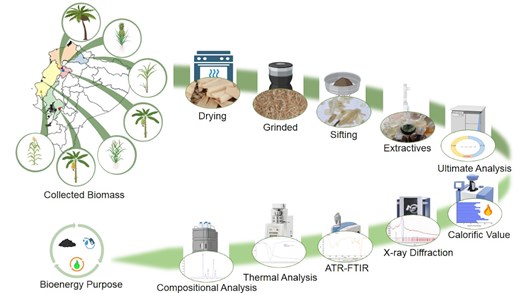-
PDF
- Split View
-
Views
-
Cite
Cite
Carlos Méndez-Durazno, Valeria Ramírez, Nilo M Robles Carrillo, María F Flores Enríquez, Cristhian M Velalcázar Rhea, Ricardo A Narváez C, Comprehensive characterization of Ecuadorian lignocellulosic biomass in terms of their candidacy for bioenergy purposes, Clean Energy, 2025;, zkaf008, https://doi.org/10.1093/ce/zkaf008
Close - Share Icon Share
Abstract
Bioenergy underpins a wide variety of technologies to transform biomass into fuels, chemicals, and biomaterials through sustainable routes. Significant advances in biomass valorization towards understanding their potential for energy production have occurred over the last decades. However, the complexity gap to utilize the entire lignocellulosic biomass simultaneously, remains overwhelming largely, which severely impedes the development of a bioresources-based economy. The exploration of complex characteristics of lignocellulosic biomass fractions, including both chemical and structural aspects, is imperative. In the present study, 17 Ecuadorian lignocellulosic biomass were prepared and extensively characterized to understand their compositional and structural characteristics through analytical approaches such as carbon–hydrogen–nitrogen–sulfur analysis, bomb calorimetric, X-ray diffraction, thermogravimetric analysis, Fourier transform infrared spectroscopy. Regarding volatile matter content, all biomass sources presented remarkable levels ranging from 65.01 to 86.13%. Ash content was found in a range of 5.67 to 17.53%. Results show that the banana pseudostem displayed the highest cellulose content (59.56 %). The lowest cellulose content was recorded in oil palm kernel shell (9.55%). The largest calorific value was found in sugarcane bagasse (22.62 MJ kg-1), while the minimum (12.50 MJ kg-1) was found in banana rachis. The highest crystallinity index was observed in rice husk followed by rice straw and plantain pseudostem. These results provide scientific guidance of the potential of collected biomasses as promising candidates for bioenergy production and related industrial applications.



